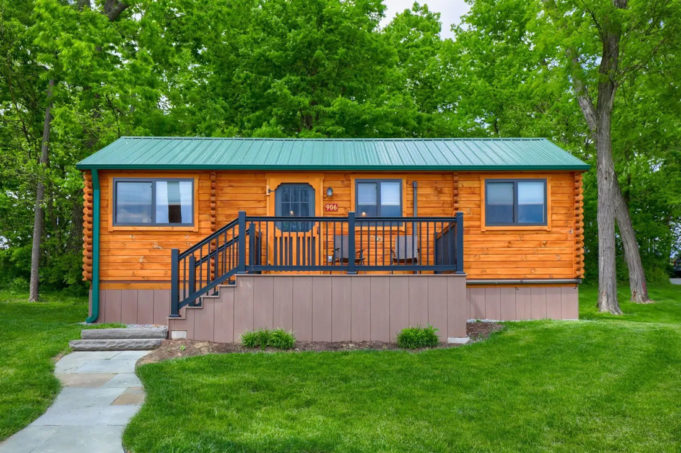The hum of the city never really stops. Traffic rolls through the night, porch lights burn past midnight, and even the quiet moments buzz with notifications. For a growing number of Texans, that constant noise feels like a tax. The new definition of luxury is space to breathe where the signal fades and silence feels like wealth.
Off-grid living used to belong to survivalists and wanderers. It looks different now. Think handcrafted cabins tucked among pines, solar setups that power an espresso machine, and mornings where your nearest neighbor is a mile of sagebrush away. These unplugged retreats are less about abandoning modern life and more about taking charge of it.
The shift is cultural as much as practical. Remote work, climate pressure, and housing fatigue have pushed people toward smaller footprints and slower days. Texans who once shopped for lake houses or bigger suburbs are hunting for quiet acreage and a set of cabin keys. The pull is not the postcard view. It is the reset.
The Rise of the Unplugged Lifestyle
The appetite for simplicity keeps growing. After years of video calls, record heat, and higher costs, more Texans want a life that feels less engineered and more intentional. For some, that means swapping a five-day commute for a patch of land and a small cabin on solar. For others, it is a weekend place where the loudest sound is the wind moving through the cedar.
Across the country, off-grid living has turned into an industry of its own. Park model cabins, portable tiny homes, and modular designs now deliver real comfort without the baggage of a sprawling mortgage. The modern off-grid crowd is not anti-tech. They are careful with it. Keep the parts that help, skip the parts that steal peace of mind.
Reports tracking post-2020 housing choices point to steady growth in remote-ready and off-grid options. The appeal is control. When cities grow denser and pricier, open space starts to look like the last true luxury.
Park Model Cabins: Comfort Without Compromise
For anyone who wants to step off the grid without losing a good mattress or a working kitchen, park model cabins have become the go-to move. The best builds feel like scaled-down lodges, not glorified campers. Many arrive fully assembled, ready for a quiet view and a clean pad.
What separates today’s park models is how livable they are. Solid wood construction, tighter insulation, and simple design choices make small spaces feel warm and durable. Off-grid options like solar, rainwater capture, and composting systems mean weeks can pass without a utility hookup. No rough edges here. Just comfort that rolls.
State Snapshot: How Rules and Costs Compare
Rules change the moment you cross a county line, and the differences are even sharper from state to state. If you are weighing a cabin, a quick scan of placement rules, site costs, and climate needs will save time and money.
Texas: Rules are local, so outcomes vary by county and city. Park models fit cleanly in RV parks, while private parcels depend on zoning and any HOA limits. Site work costs are moderate in most areas, and the climate encourages a focus on cooling and securing tie-downs rather than snow loads.
Colorado: Many mountain counties prefer foundation-built tiny homes for full-time use. Park models are treated as RVs and are often limited to RV parks or seasonal stays on private land. Mountain terrain and freeze depth raise pad and utility costs, and snow and wind specs matter.
Arizona: Counties with strong RV traditions are familiar with park models in parks and age-restricted communities. Rural parcels can be more flexible than metro areas. Flat sites keep pads and utilities simpler, but heat hardening and dust control are priorities.
Utah: Interest in park model homes in Utah keeps climbing near national parks and ski corridors. Most counties treat park models as RVs, which makes resort and RV park placements straightforward and private parcels more code-dependent. Cold-weather details like skirting, higher snow loads, and freeze protection are worth budgeting for.
What’s Fueling the Off-Grid Boom
Costs keep climbing, cities sound louder, and the grid wobbles when heat spikes or storms roll in. Put that together and self-sufficiency looks less like a stunt and more like a plan. Solar arrays, compact batteries, and sensible water systems have matured enough to support daily life, not just a long weekend.
Work culture changed the math as well. Once people proved they could do their jobs from a kitchen table, a cabin desk stopped sounding far-fetched. The tools and habits for working off-grid anywhere make a full workday possible away from town, from portable power to low-draw routers and simple planning.
Energy independence pulls hard. Generate power, manage water, trim the bills, and life gets lighter. Many Texans are opting for comfort, privacy, and ample space to breathe.
Texans Take the Trend Home
Back in Texas, the off-grid idea has moved from daydream to weekend plan. Around Fort Worth, it shows up in small cabins tucked into the Hill Country, quiet plots along Lake Whitney, and long loops on two-lane roads that double as scouting trips. The goal is simple: less noise, fewer bills, and a place that feels like it belongs to you.
Buyers are not chasing square footage. They want a space that cools efficiently in August, sips power from a modest solar array, and avoids a 30-year payment. Some keep it personal, a retreat for long weekends and holidays. Others set up a second use case, where a cabin covers part of its costs when they are back in town. Flexibility and lower overhead turn interest into action.
Travel habits follow the same line. A Sunday drive becomes a practical survey of small towns, trailheads, and lakes with decent access roads. The same loop that clears your head can help you spot the right parcel, the right view, or the right distance from town, which is why so many locals plan weekend getaways around North Texas.
A compact footprint means less to maintain and more time outside. Add a rain tank, a few panels, and a reliable mini-split, and a spare piece of land starts to feel like home. That is the draw: a simple setup, a quiet morning, and a place you are eager to return to.
The Future of Luxury: Freedom, Not Footprint
Luxury is shrinking in size and growing in meaning. For years, comfort was measured in square footage, extra bathrooms, and an open kitchen. Lately, it looks like hours reclaimed, quiet found, and sunlight on a porch no one else can see. The shift says as much about burnout as it does about design. People want fewer obligations and more control over their time.
Off-grid living scratches that itch in a way few conveniences can. A small cabin with its own power supply and just enough room for the essentials feels like a clean break from excess. You can have espresso and Wi-Fi if you want them, and you can turn them off when you do not. When the city noise falls away and the night sky takes over, the feeling is relief, not sacrifice.
That balance keeps drawing Texans toward unplugged retreats. It is not running from modern life. It is trimming it down to something livable. A smaller home, a steadier rhythm, and a bit of quiet in a world that will not stop humming. If comfort has a new definition, it starts there.
Closing
Every few years, Texans redraw the line that defines freedom. Lately, it is a cabin key, a solar charger, and a short list of things that actually matter. Off-grid living reads like a retreat, yet it works more like a recalibration. Whether it becomes a weekend escape or a full-time switch, the promise is the same: peace that does not depend on proximity. For anyone ready to test that idea, the road out of Fort Worth is already waiting.












